“Spanish friars mercilessly flogged Filipinos!”
This modern concept of the Indio being flogged by a Spanish friar under the hot tropical sun is what keeps the motor of hispanophobia running. There is no more need to expound what an indio means; simply put, indio is a Spanish word for “native”. The so-called “insulares” or Spaniards who were born in Filipinas were the first Filipinos. Through time, however, Hispanization further blurred this. Indios/natives who were Christianized, who started learning and talking in Spanish, and who imbibed the culture from the West began referring to themselves not as indios but Filipinos as well. And this posed not a problem to the insular. As a matter of fact, the insular never considered themselves as “Spaniards” in the strictest sense of the word. They, as well as the Hispanized indios, simply referred to themselves as FILIPINOS. Filipinas is where they were born and where they grew up (patria chica).
To continue, those indios —whether they belonged to the Tagálog race, Ilocano race, Bicolano race, etc.— who were Hispanized in effect lost their “indio” identity (but not completely, of course) when they assimilated themselves to an influx of cultural dissemination coming from the West. There is nothing wrong with this. During those days, it was perfectly normal, as the influx of a foreign culture had no hint of any personal profit and even promoted cultural osmosis in the local scene (contrary to popular belief, Spain NEVER became rich when they founded and colonized our archipelago).
Anyway, because of cultural dissemination, the Hispanized Tagálog ceased to become Tagálog: he became Filipino. The Hispanized Ilocano ceased to become Ilocano: he became Filipino. The Hispanized Bicolano ceased to become Bicolano: he became Filipino. In other words, the term Filipino is not a race but a concept (there is no such thing as a Filipino race because our country is composed of several races). But this concept put a premium over our collective identities, giving us a patriotic “swagger” to refer to ourselves under one homogeneous identity: EL FILIPINO.
To Hispanize, therefore, is to Filipinize. And to put it more bluntly, our “Spanishness” is what makes us Filipino, not our “indio” identity (which is merely a substrate). If we take away our indio identity in us, our Hispanic identity will still continue to flourish. But if we take away our Spanishness, we will go back to becoming savages, and go back to the mountains as “cimarrones“.
Take for example Cali Pulaco, popularly known today as “Lapu-lapu”. This fellow, an indio ruler from Mactán, virtually resisted change. His neighbor, Rajáh Humabon, did not. Humabon accepted change, was baptized into the Christian faith, and received a Christian name: Carlos (named after then Spanish King Carlos I). Remember that culture is not static, should never be static. His men accepted the Santo Niño (and the icon’s culture) as part of their own. Those who were baptized with him died as Christians; Lapu-lapu and his people died as heathens.
And even up to now, Cebuanos celebrate the feast of the Santo Niño with frenzied fervor. Because the Santo Niño has become part of them as Cebuanos, and part of us as Filipinos.
During the Spanish times, there were many other ethnic groups who resisted change — the Ifugáos up north, the Aetas of the mountains, the Mañguianes of Mindoro, the Muslims of the south, etc. And because they resisted change, they missed the opportunity to become “one of us”. Technically, they are not Filipinos. They are Filipinos only by citizenship, most especially if we view them from a socio-historico-cultural perspective. Look at them now: no disrespect, but they look pathetic and backward because they resisted change. The mountain tribes of the Cordilleras still wage against one another. The Aetas continue to be forest dwellers. The Muslims still raid and kidnap Christians for a ransom and to have their turfs seceded from Filipinas. Etc. etc. etc. Because, then as now, their culture remains static. They still remain as INDIO as ever before.
Let us accept the fact that our Spanish past is what made us Filipinos in the first place. it is this identity which removed us from the backwardness of a static culture that refused to accept change. Let us accept that we are Filipinos because we are Christians (Catholic), we use cubiertos whenever we eat, we STILL SPEAK Spanish (uno, dos, tres, lunes, martes, miércoles, enero, febrero, marzo, silla, mesa, ventana, polo, pantalón, camisa, etc. etc. etc.), we eat adobo and pochero, we have Spanish names, we practice and value “amor propio“, “delicadeza“, “palabra de honor“, our town fiestas are the most festive and lavish in the whole world, we enjoy the “tiangues” of Divisoria, etc.
No soy indio. Porque soy filipino.
Read part 1 here.
* E * L * F * I * L * I * P * I * N * I * S * M * O *
This blogpost is dedicated to Saint James the Greater, patron saint of Madre España, whose feast day falls today. ¡Viva Santiago Matamoros!



